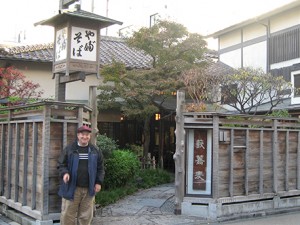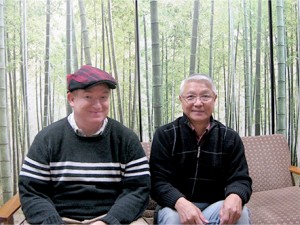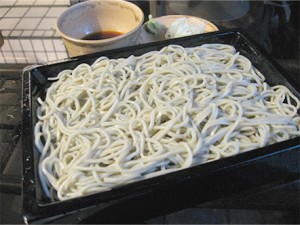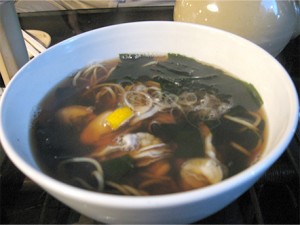 |
セインさん。今回、ご案内するのは「かんだ やぶそば」です。創業は明治13年(1880)。神田で130年余り続いているお蕎麦屋さんの4代目・堀田康彦さんにお話をうかがいます。さあ、入りましょう。
Thayne-san, today we will be visiting Kanda Yabusoba. It opened in 1880. Let’s talk with Hotta Yasuhiko, the fourth-generation owner of this soba shop in its 130-year history. Well, shall we go in? |
|
|
| (堀田) |
ようこそ、セインさん。堀田です。
Thayne-san, welcome. I’m Hotta. |
|
|
 |
堀田さん、はじめまして。セインです。「かんだ やぶそば」は、外国人にも有名な店ですので、いろいろな話を伺いたいのですが……。
実は、僕が初めて蕎麦を食べた時、「これは大人の食べ物」だと思ったんです。アメリカ人は大人も子どももほとんど同じものを食べますが、日本には大人にならないと、そのおいしさがわからない食べ物があるんじゃないかな、と。蕎麦のおいしさって、初めて食べる人にもわかるものなのでしょうか。
Hotta-san, pleased to meet you. I’m Thayne. Kanda Yabusoba is also famous among foreigners, so I have lots of questions to ask.
To tell the truth, the first time I ever had soba, I thought it was really a food for adults. Americans, young and old, tend to eat the same things, but in Japan I think there are some foods that you just can’t appreciate until you get older.
Maybe soba is one of those foods that requires a mature palate to really enjoy. |
|
|
| (堀田) |
おもしろい話ですね。日本食の代表といえば、寿司、天ぷら、うなぎの蒲焼、そして蕎麦。でも、そのうち蕎麦だけが油脂が含まれていない料理なんです。
天ぷらは揚げ物ですし、寿司や蒲焼は魚の脂があって、その油脂がおいしさの大きな要素になっています。でも、蕎麦だけは脂っけがない。それどころか、蕎麦は、それ自体には味もありません。ですから、外国の人や子どもが初めて食べておいしいと思うかといわれると……難しいかもしれません。
じゃあ、何が蕎麦のおいしさなのかというと、まずは香りなんです。そして、この香りを最も感じられる食べ方が、あの、ズズッと音をたててすすり込む食べ方なんです。
That’s interesting. When we think of Japanese cuisine, we think of sushi, tempura, grilled eel, and soba. But of those foods, only soba doesn’t use any oil or fat.
Tempura is a fried food, and sushi and eel have natural oils from the fish, and this oil is a big element of the taste. Soba on the other hand, isn’t oily at all. We actually have to say that soba itself is tasteless. So will foreigners and children enjoy soba when having it for the first time? That might be difficult.
In terms of what makes soba delicious, I would say that first is the aroma. In order to best experience soba’s aroma, you have to slurp the noodles while making a slurping sound. |
|
|
 |
セインさんは、蕎麦をすすり込んで食べられますか?
Thayne-san, can you slurp your soba noodles? |
|
|
 |
大丈夫、任せてください!(笑)
No problem—leave it to me! |
|
|
| (堀田) |
蕎麦は、箸と猪口(ちょこ)で食べます。蕎麦つゆの入った猪口を持ち上げて、箸で蕎麦を取り、つゆをさっとつけて口のところまで持っていく。箸の役割はここまでで、あとは口がすすり込む。このすすり込むという行為で、蕎麦とともに空気が口の中に入って、蕎麦の香りを感じることができるんです。
さらに、つゆも同時に口の中に入りますから、口のなかで調味がされる。ただし、そこでいつまでも噛んだりせずに、のどごしを楽しむというのが江戸の蕎麦なんです。
Soba is eaten with chopsticks and a small cup for the sauce. You hold up the cup with the soba sauce, take some noodles in your chopsticks, quickly dip the noodles in the sauce and bring them to your mouth. The role of the chopsticks ends here; your mouth does the rest. This slurping action brings air into your mouth along with the noodles, bringing out the soba aroma.
The soba sauce also enters your mouth at the same time, giving the noodles flavor. Before chewing the soba completely, be sure to swallow and enjoy the sensation of the noodles going down. That’s Edo soba! |
|
|
 |
あの食べ方は、蕎麦の風味を楽しむための最良の方法だったんですか!
So that’s how you eat soba to best enjoy the flavor! |
|
|
| (堀田) |
ええ。江戸っ子は、蕎麦つゆをたっぷりつけたり、口に押し込むように食べたりするのを「野暮」だと言って嫌うんですが、単に格好をつけているだけじゃないんです。
That’s right. Old-time Tokyoites call people who drown the noodles in sauce and shovel them into their mouths uncouth, but they are not just being snobby for the sake of being snobby. |
|
|
 |
最初に蕎麦つゆをちょっと飲むのが正式だと聞いたこともあるんですが、蕎麦の正しい食べ方ってあるんでしょうか?
I’ve heard that sipping the soba sauce a little before eating the noodles is proper, but is there a correct way to eating soba? |
|
|
| (堀田) |
最初に蕎麦つゆを飲むというのは、初めて行った店で、どんな蕎麦つゆなのかを味見するためでしょう。つゆが辛ければ、少なめにつけて食べればいい。ですから、いつも通っている店なら、そんなことをする必要はないですよ。
それに、本物の蕎麦とか、正式な食べ方なんてないんです。
たとえば、東京では細くて長い蕎麦が一般的ですが、地方に行くと太くて短い蕎麦があるでしょう。そういう蕎麦を江戸風にスルスルッと食べようったって喉をつまらせちゃって食べられないでしょうし、おいしくない。
Sipping the soba sauce first is done at restaurants you haven’t been to before to get a feel for how much to add to the noodles. If the sauce is salty, you don’t need very much. So at restaurants you go to often there’s no reason to taste the sauce first.
And there’s really no such thing as “real” soba or a single proper method of eating it.
For example, soba noodles in Tokyo are typically long and thin, but in other parts of the country you can find thicker, shorter noodles. If you try to slurp those kinds of soba noodles like you would Edo soba, they would probably get stuck in your throat, not making for a very pleasant meal.
|
|
|
 |
いろいろな蕎麦があって、それにあった食べ方がある、と。
So what you’re saying is, there are lots of kinds of soba, and an appropriate way to eat each of them. |
|
|
| (堀田) |
そうです。江戸は圧倒的に男性が多い町でしたから、外食文化が栄えました。特に、時間がなくてもパパッと食べて、すぐに仕事に戻れるファストフードが発展しました。握り寿司は、その代表格です。そして蕎麦も、江戸ではつなぎを入れて細く長く打って、短時間にすすり込んで食べられるようにしたわけです。つまり、江戸の蕎麦が細長いのは、江戸が忙しい町だったから。
That’s right. Edo was a town with a lot more men than women, and as a result, a culture of dining out flourished. People had to eat quickly and return to their jobs right away, so the availability of “fast food” really developed. Nigiri sushi was typical of that “fast food” style. And soba was made long and thinly so that it could be slurped up quickly. In other words, the reason Edo soba is long and thin is because everyone was busy.
|
|
|
 |
なるほど! では、関東の蕎麦つゆの味が関西に比べて色や味が濃いのにも理由があるんですか?
I see! Is there also a reason why soba sauce in the Kanto region is darker and has a stronger flavor than that of Kansai? |
|
|
| (堀田) |
一つは、江戸には肉体労働をする人が多くて、味の濃い食べ物を求めたということ。そして、銚子や伊豆で揚がるカツオで作る鰹節と野田の醤油という江戸周辺から運ばれてくる特産品が、そのリクエストに応える濃厚なつゆを可能にしたんです。
一方、関西は北前船で北海道の昆布が入ってきましたから、昆布だしの繊細な味わいが料理のベースとなりました。さらに素材の色や味を生かす淡口醤油が考え出されて、さまざまな料理に使われていったんです。
For one thing, Edo had lots of physical laborers who preferred stronger-flavored food.
Local products from the greater Edo area, such as flakes made from bonito from Choushi and Izu, and soy sauce from Noda, made it possible for shops to cater to these tastes.
On the other hand, in the Kansai region the Kitamaesen* brought kombu down from Hokkaido, and the delicate flavor of kombu became the base for soba sauce there. A light-colored soy sauce was also invented that preserved the color and flavor of foods it was added to, and this soy sauce became widely used in the Kansai region.
*Kitamaesen was a merchant ship engaged in trade along the Sea of Japan coast during the Edo Period.
|
|
|
 |
蕎麦に限らず、そういう歴史的・社会的な背景を知っていると、「食」の楽しみが広がりますね。
When you know the historical and cultural background of soba and other foods, you can enjoy it even more, don’t you think? |
|
|
 |
ところで「かんだ やぶそば」は、庭も建物も情緒があって僕も大好きなんですが、いま、神田の町は再開発が進んでいますね。この店もビルに建て替えて大きくしたら、もっと儲かるのに、と考えたりはしませんか?
By the way, Kanda Yabusoba’s garden and building have a great atmosphere, but I’ve noticed that Kanda is seeing a lot of redevelopment. Have you thought about renovating your shop and expanding into a larger space to increase your profits? |
|
|
| (堀田) |
店というのは、伝統のものを守り伝えていくのと同時に、時代に合わせてどんどん変わっていかなければ継続しないんです。ですから、この先、店を建て替えることもあるかもしれません。たとえば、耐震基準に満たないので営業してはいけない、と言われるかもしれませんから。
ただし、利益を大きくするためにビルに建て替える、ということはこの先もないと思います。たしかに、店が大きくなれば資産が増えるかもしれません。でも、生活していくのに、それほどたくさんのお金は必要ないでしょう?それよりも、この町をどうしていきたいか、住民として、ここで商売をしている者として何をしたらよいのか、どういう店であったらいいのか、そこを考えることが大切だと思っています。
While it’s important to preserve past traditions for future generations, a business also has to change with the times to survive. For that reason, it’s possible that this shop will need to be rebuilt in the future. At some point, if the shop doesn’t meet the earthquake building codes, we might not be able to go on doing business here.
But I don’t think we will ever renovate the shop simply to increase our profit. Naturally, if we expand then we may make more money than we do now. But, really, we don’t need a lot of money just to live, don’t you think? As both a Kanda resident and business owner, I feel it’s more important to think about what kind of place we want to live in, and what kind of businesses and stores we want to shop at.
|
|
|
 |
シンプル・ライフの考え方ですね。
It sounds like you believe in the simple life. |
|
|
| (堀田) |
それから、今、自分の考えで店を大きくしても、跡継ぎに力量がなければ大きな店を動かしていくことはできません。老舗と言われる店の多くがむやみに店を大きくしないのは、一つにはそういう安全策をとっているとも言えると思います。店で働いている人たちが一人前になって独立を考えるようになったら暖簾分けということはありますが、母船をどんどん巨大化する必要はないという考え方です。
Yes, and also if we decide to expand the shop now, it will take a lot more hands to keep it going after I retire. I think you could say that one reason most old shops don’t expand their business without good cause is because they are playing it safe; they don’t want to get so large they can’t manage things. People who work in shops sometimes open a new branch if they decide they want to be independent, but our thinking is that it’s not necessary to keep expanding the main business.
|
|
|
  |
企業規模を大きくする西洋型の経営とは、考え方の根本がまったく違うんですね。
日本に老舗が多い理由が、少しわかってきたような気がしました。
今日は蕎麦談義から、生き方論まで、本当にありがとうございました。
That’s a completely different way of thinking from the Western business philosophy, which strives for constant expansion.
I have a feeling I’m beginning to understand the reason why Japan has lots of shops that have been around for such a long time.
Thank you so much for your time today! It was a pleasure to learn about soba and also your philosophy! |
|
|
|

「かんだ やぶそば」入口。気品あふれる落ち着いた風情も、この店ならでは。
This is the entrance to Kanda Yabusoba. You won’t find the same refined and tranquil atmosphere anywhere else. |
|
|
|

神田の生まれの堀田さんは、ほんとの江戸っ子。
Hotta-san, born in Kanda, and a true Tokyoite. |
|
|
|

名物「せいろうそば」。国産の玄そばを挽き、蕎麦粉10、つなぎ1の割合で打っている。
The shop’s specialty, Seiro soba. Domestically-produced soba is ground and mixed 10 parts buckwheat to one part wheat flour. |
|
|
|

季節の蕎麦も人気。この日、セインさんが食べたのは、牡蠣そば。
Seasonal soba dishes are also popular. On this day, Thayne-san had hot soba with oysters. |
|
|
|
(文)太田美代 (英訳)デイビッド・A・セイン |
 1959年、米国生まれ。翻訳家、通訳、英会話経営者(エートゥーゼット英語学校)。カリフォルニア州アズサパシフィック大学で社会学修士号取得。証券会社勤務を経て来日し、多岐にわたって活躍中。 豊富なアイディアと行動力、そして誠実な飾らぬ人柄も万人に愛されている。 著書に『その英語、ネイティブにはこう聞こえます』(主婦の友社)、『使ってはいけない英語』(河出書房新社)、『英語ライティングルールブック』(DHC)、『英語でしゃべらナイト』(NHK出版)など多数。『Mainichi Weekly』(毎日新聞社)の連載や『水は答えを知っている」(The Hidden Messages in Water)等の翻訳も好評。 http://www.smartenglish.co.jp/
1959年、米国生まれ。翻訳家、通訳、英会話経営者(エートゥーゼット英語学校)。カリフォルニア州アズサパシフィック大学で社会学修士号取得。証券会社勤務を経て来日し、多岐にわたって活躍中。 豊富なアイディアと行動力、そして誠実な飾らぬ人柄も万人に愛されている。 著書に『その英語、ネイティブにはこう聞こえます』(主婦の友社)、『使ってはいけない英語』(河出書房新社)、『英語ライティングルールブック』(DHC)、『英語でしゃべらナイト』(NHK出版)など多数。『Mainichi Weekly』(毎日新聞社)の連載や『水は答えを知っている」(The Hidden Messages in Water)等の翻訳も好評。 http://www.smartenglish.co.jp/











